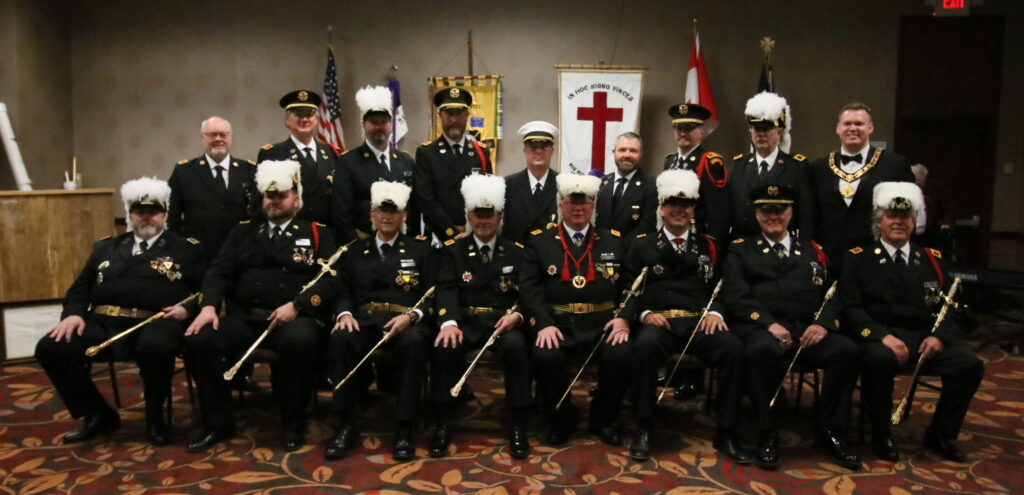Grand Commandery of Knights Templar

The Grand Commandery of Knights Templar of Minnesota
The Knights Templar Mission: To unite Masons by answering the noble call to practice chivalry and charity in preservation of historic Christian traditions. Every Christian Mason should be a Knight Templar.
Who we are...
Integrity, Obedience, Courage
The purpose of the Grand Commandery of Knights Templar of Minnesota is to provide guidance and support to the Commanderies and Sir Knights of Minnesota, under the oversight of the Grand Encampment of Knights Templar of the United States, consistent with our core values, our Masonic traditions and the Christian faith.
The Knights Templar is a Christian-oriented fraternal organization that was founded in the 11th century. Originally, the Knights Templar were laymen who protected and defended Christians travelling to Jerusalem. These men took vows of poverty, chastity and obedience, and were renowned for their fierceness and courage in battle.
Today, the Knights Templar display their courage and goodwill in other ways. They organize fund-raising activities such as breakfasts, dinners, dances, and flea markets. They support Masonic-related youth groups and they raise millions of dollars for medical research and educational assistance.
Currently, Templar membership consists of people from all walks of life, including doctors, lawyers, clergy, businessmen and entertainment personalities, all of whom profess a belief in the Christian Religion.
Origin of Our Grand Commandery

- The Grand Commandery of Knights Templar of Minnesota will be celebrating its 150th anniversary. However, the history of Templary in Minnesota predates the formation of the Grand Commandery by at least a decade, when a group of Sir Knights petitioned the Grand Encampment for dispensation to establish Damascus Commandery in Saint Paul, Minnesota. During these formative years, three other Commanderies were granted dispensation, Zion Commandery in Minneapolis, Couer De Lion Commandery in Winona, and Mankato Commandery in Mankato. These four Commanderies met in Saint Paul on Monday, October 23, 1865, to form the Grand Commandery of Knights Templar of Minnesota. Authority for this occasion, was granted by Heruy L Palmer, then Grand Master of the Grand Encampment of Knights Templar of the United States of America.
If one reaches further back in time, the Grand Encampment was formed only a half century before in 1816. Still further into the dim reaches of time, today’s Knights Templar may trace their heritage to the valiant and chivalric orders of knighthood so intimately tied to the Crusades.
The journey back into time does not stop there, however. The hearts of all Knights Templar are deeply rooted in Freemasonry, one of the oldest and most honorable institutions in the world. It is significant to note that all Knights Templar are Freemasons, but conversely, that all “Freemasons” are not Knights Templar. At first, this may seem a bit paradoxical; the following comments are offered in explanation.
The foundation of Freemasonry is the Blue Lodge. The Blue Lodge, in Minnesota, is a “York Rite Lodge” organized in a manner that consists of three York Rite degrees through which a candidate must pass to be accepted into membership. These degrees begin with Entered Apprentice, progress through Fellow Craft, and culminate with Master Mason. This progression can be compared with the stages through which craftsmen in the various trades advance from apprentice through journeyman to master. Masonry communicates its teachings and philosophies through allegorical portrayals and interpretations of these stages, equating them to the process in which one strives to achieve high moral goals in life. All candidates must complete the three aforementioned degrees before they may become members of the Masonic fraternity.
Additional stages of Masonic education may occur after the completion of the Blue Lodge degrees. The candidate may choose between two avenues or Rites in his advancement and education: the York Rite or Scottish Rite. Each of these Rites, consist of a number of degrees, similar to the format of the Blue Lodge. The Master Mason may continue his education in York Rite Masonry by continuing on through the next three York Rite Bodies, which each comprise a number of degrees or “Orders”. The first four degrees after the Blue Lodge comprise the Chapter of Royal Arch Masons, three degrees comprise the Council of Cryptic Masons, and three “orders” comprise the Commandery of Knights Templar.
The Scottish Rite consists of 32 degrees, (a 33rd degree is conferred as a special honor to recognize exemplary dedication and service).
The Commandery has the unique distinction within the framework of Masonry of being founded upon the principles of the Christian religion and the practice of Christian virtues. With the exception of the work in the first of the orders, the Order of Red Cross, the Order of Malta and the Order of the Temple are directly structured upon the lessons contained within the New Testament. Thereby, the Knights of Malta and the Knights Templar trace their origins to the Crusades and the circumstances regarding the period of history surrounding the pilgrimages to the Holy Sepulcher.
In marking the event of this 150th year of the Grand Commandery in Minnesota, the topic of its history deserves special note. This is a time to look back with reverence for an illustrious heritage. It is also a time to look forward with great expectations for the future. The chapters contained in this history are intended to chronicle significant events and to tell of hopes and aspirations, of successes and failures, of joys and disappointments, and of encouragement and chastisements. Above all, however, they are intended to celebrate the pride which one feels as a Minnesota Knight Templar.